CJ4 debut
More proof: There’s no substitute for power
Ice-fighting in the CJ4
To prevent ice from forming (anti-icing) and to rid it once it has formed (deicing), Cessna’s Citation CJ4 uses a hybrid system for its airfoil leading edges. The wing leading edges are anti-iced by engine bleed air that comes from the engines’ compressor sections and is routed to the wings and engine inlets. That’s very hot air, so the lines that deliver it are insulated, and a tube with small exhaust ports—some call them “piccolo tubes”—is fitted with the chrome-plated wing anti-ice panels.
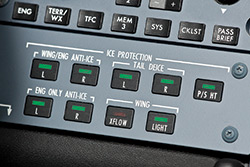 The horizontal stabilizer is deiced by means of an inflatable rubber deice boot. It’s inflated by bleed air as well, and the boots can be inflated and deflated in cycles. All the CJ4’s ice protection control push-button switches are on the pilot’s left subpanel, which is tilted for better visibility and access.
The horizontal stabilizer is deiced by means of an inflatable rubber deice boot. It’s inflated by bleed air as well, and the boots can be inflated and deflated in cycles. All the CJ4’s ice protection control push-button switches are on the pilot’s left subpanel, which is tilted for better visibility and access.
The tail’s vertical stabilizer has no ice protection at all! That’s because icing certification test flights showed that ice simply didn’t accumulate there to any significant degree. Odd, but that’s the case with many other business jets as well.
As explained in the accompanying article, the CJ4’s windshields are electrically anti-iced. So are the airplane’s angle of attack sensor vane, pitot tubes, and static ports.
How do you know if ice is forming? Easy. Two glareshield-mounted windshield ice detection lights shine small reddish beams on the windshield; they illuminate the slightest accumulations of ice. Then there’s the wing inspection light for flying at night. Push a button on the ice protection panel, and a fuselage-mounted light shines a beam on the left wing’s leading edge.
Does using bleed air for ice protection compromise performance? You bet. Diverting bleed air away from the engine core reduces thrust, so climb rates and airspeeds can sag—especially when temperatures are higher than standard. Even so, that’s not much of a problem with the comparatively powerful CJ4’s Williams FJ44-4A engines. But lighter jets with smaller engines can really suffer. —TAH
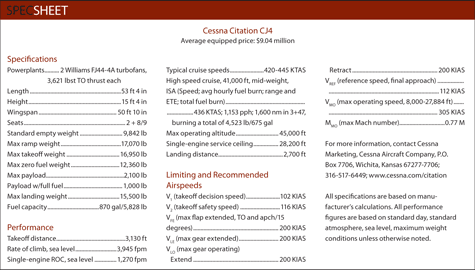
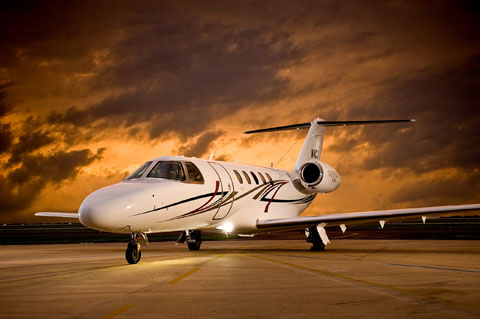
Cessna’s new Citation CJ4 takes the company’s CJ line one step closer to the midsize business jet category. The CJ4, announced in 2006, is the seventh of the CJ series (eighth, if you count the Mustang) and offers more in every department: power, speed, cabin size, and plenty of equipment that ordinarily would be optional.
Turbine Edition Table of Contents
- A path worth taking
- Yaw dampers
- What it looks like: Heated Brakes
- What to expect when you step up
- Lots of new products in development
The extra power comes from the airplane’s twin 3,621-lbst Williams FJ44-4A engines, which create a total of 1,600 more pounds of thrust than its CJ3 predecessor. At the same time, TBO is extended to 5,000 hours. That’s 1,000 more than the CJ3’s FJ44-3A engines. Speed wise, Cessna claims the CJ4 can reach a high-speed cruise of 453 KTAS while cruising at 31,000 feet at mid-weight. That’s 37 knots faster than the CJ3. And maximum range—posted as 2,000 nm—is some 200 nm greater than the CJ3’s.
The CJ4’s swept wing helps it reach that extra speed. The sweep is modest, at 12.5 degrees, and the overall wing design borrows a lot from Cessna’s much larger Sovereign. It’s the first CJ to have a swept wing and, according to a spokesman, the slight sweep “lets us break the straight-wing CJs’ 415-to-417-knot barrier.”
Standout improvements
Cessna made its name in the jet market by continually offering small, incremental improvements in performance, size, and useful load. So it is with the CJ4, but this time around the company upped the ante quite a bit. Here are the most significant of the CJ4’s improvements:
- Glass windshields, electrically heated for ice protection, are new with the CJ4. Gone are the externally mounted bleed-air ducts that aim hot air at the windshields of previous CJs.
- Dual alternators—separate from the engine-driven generators—provide power for windshield heat. These alternators can also be used to power the entire ship in the unlikely event of a dual generator failure.
- A redesigned door is wider than earlier CJs’ and features a single-action lever for opening and closing.
- A four-panel spoiler system was added for smoother, more rumble-free deployment in flight. There’s also a ground spoiler position that can be used for help in braking. Panels then open on both the upper and lower surfaces of the wing.
- A lithium-ion battery takes the place of the usual nickel-cadmium type. It weighs 30 pounds less than a nicad and requires no deep-cycle servicing.
- Single-point refueling is standard, with the fueling port ahead of the right wing root.
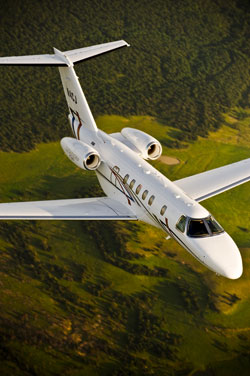 The Rockwell Collins Pro Line 21 avionics come with electronic charts, TCAS II, Mark VIII EGPWS, XM WX datalink weather, an Aircell Axxess II Iridium satphone—all standard. Options include a second FMS, an HF radio, an ADF, and a flight data recorder.
The Rockwell Collins Pro Line 21 avionics come with electronic charts, TCAS II, Mark VIII EGPWS, XM WX datalink weather, an Aircell Axxess II Iridium satphone—all standard. Options include a second FMS, an HF radio, an ADF, and a flight data recorder.
The Rockwell Collins Venue cabin entertainment system, complete with three monitors, is standard. It includes XM satellite radio and ports for audio and video inputs. An iPod docking station is optional.
There’s a 20-inch cabin stretch, thanks to a plug forward of the door. This, along with a four-inch widening of the cabin at the floor level, makes for a more spacious cabin than other CJs. Also, there’s an enlarged refreshment center and coat closet between the cockpit and the door.
In flight
I flew with Cessna’s Alex Unruh for the CJ4 familiarization flight at Wichita Mid-Continent Airport, and he guided me through the quite simple starting procedure. The engines, after all, are FADEC-controlled, and starting is a matter of pushing two buttons. At 14,750 pounds with four aboard and 3,970 pounds (592 gallons) of fuel, we were well under the airplane’s 16,950-pound MGTOW—and the takeoff performance underscored the CJ4’s boost in thrust.
For a standing start, shove the thrust levers into the TO position, release the brakes, and hang on. There’s a definite surge of acceleration, our V 1 of 94 KIAS came and went, and soon we were in a 240-KIAS climb doing 4,500 fpm.
At 18,000 feet we were still climbing at 2,400 fpm, and it took us a mere 19 minutes to reach FL400. There, we leveled off and saw a 443 KTAS cruise under ISA-plus-2 degrees conditions. This was two knots faster than book. Meanwhile, fuel burn was slightly higher than book, at a total fuel flow of 1,230 pph. Unruh did some calculations and said that at our weight, performance, and altitude we could fly nearly 1,800 nm—far enough to take us to, say, Seattle or Bangor, Maine.
 My airwork proved the CJ4’s good manners, even in full stalls and single-engine work. A stick shaker goes off a few knots prior to the stall, and holding aft stick pressure resulted in very mild buffeting as the full stall ensued. Recovery was almost instantaneous with the application of power and a slight lowering of the nose.
My airwork proved the CJ4’s good manners, even in full stalls and single-engine work. A stick shaker goes off a few knots prior to the stall, and holding aft stick pressure resulted in very mild buffeting as the full stall ensued. Recovery was almost instantaneous with the application of power and a slight lowering of the nose.
Unruh pulled an engine on two takeoffs. A rudder bias system kicked in to help in counteracting the yaw created by the asymmetric thrust, and by holding the V 2 of 111 KIAS we saw a 1,500-fpm climb rate.
For landings, Cessna posts V REF speeds ranging from 94 to 112 KIAS, depending on weight. Our target speed turned out to be 111 KIAS, although Unruh said that maintaining the V AP (final approach) speed of 107 KIAS would produce a smoother touchdown. I tried it both ways, and he was right. That, or I was getting better at landing.
Market forces
The CJ4 has very strong attributes, but the competition is equally strong. Embraer’s Phenom 300 is perhaps the biggest thorn in the CJ4’s side. Its speeds, ranges, weights, and loads are virtually the same as those of the CJ4. And it’s priced less than the CJ4’s $9.04 million (typically equipped). Moreover, its cabin width and overall volume are greater.
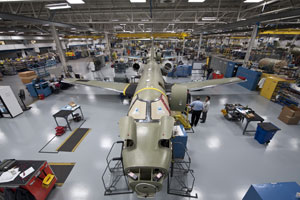 The CJ4 also competes with the smaller Learjets—the 45XR, especially—which is a testament to the CJ line’s ever-growing cruise speeds. You certainly don’t hear many of those old “Slow-tation” jokes, and for good reason. Cessna’s service network is as strong as they come, and this is where the CJ4 holds a great advantage over the Phenom 300.
The CJ4 also competes with the smaller Learjets—the 45XR, especially—which is a testament to the CJ line’s ever-growing cruise speeds. You certainly don’t hear many of those old “Slow-tation” jokes, and for good reason. Cessna’s service network is as strong as they come, and this is where the CJ4 holds a great advantage over the Phenom 300.
The tough economic times have taken their toll, but with 150 in the CJ4 order book—and, at this writing, 15 to be delivered in 2010—Cessna plods on despite layoffs and other sad economic news. As the new flagship of the CJ line, the CJ4 sets a new standard for light jets. A trend is under way: “Light” business jets are picking up more midsize-jet attributes.
E-mail the author at [email protected].


